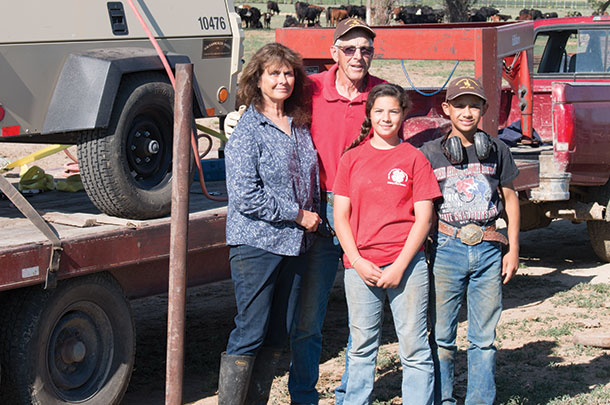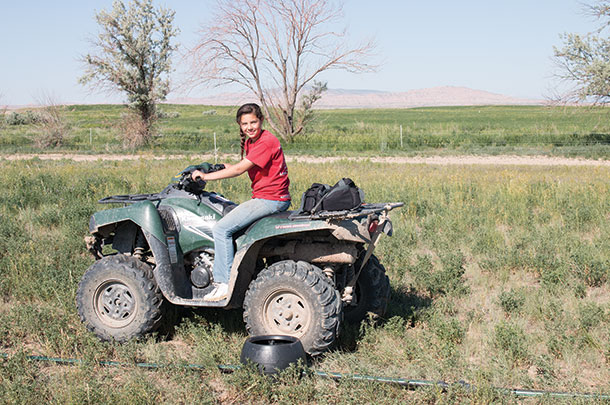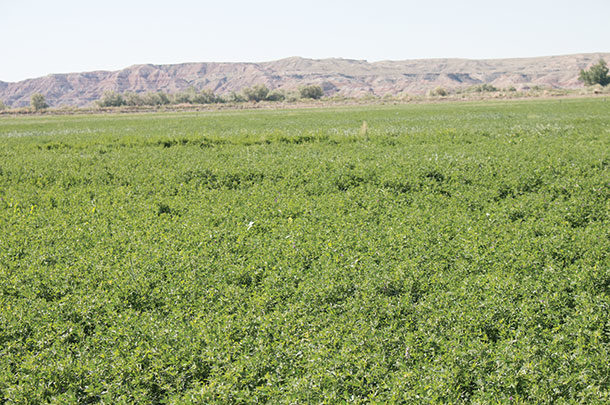I wish I could paint a picture that would capture that beautiful mind – the mind that can change gears and is open to the possibilities that maybe, just maybe, the sheep haven’t been totally sheared. Occasionally, I run into one of these minds – the creative ones, the ones who shed former mindsets to consider possibilities. I found one a few months ago belonging to hay and cattle producer Phil Boreen.

Phil and Kate Boreen, with their children Isobel, Karina, Nicole and Nathaniel, ranch 732 acres near Otto, Wyoming (their oldest daughter, Misty, lives off the ranch.) Phil was a fireman in Seattle for 30 years, and when he retired from firefighting he was still young – not ready to sit in a porch rocker.
So he and Kate researched available properties, evaluated taxes, energy costs, water costs and water availability, and bought the ranch in the Bighorn Basin. They were barely unpacked when the ditch rider dropped by and told them they would have only 12 percent of their water allotment for the year. It was 2002, the beginning of one of the worst droughts in Wyoming tree-ring history.
Phil says, “The learning curve was like this,” as he gestures by pointing skyward. Their thinking rapidly shifted gears. “Things kiln-dry out here,” Kate says. “Early on, we concentrated on efficiency and surviving the drought.” They quickly put together a five-year plan for water conservation improvements.
The five-year plan included burying pipe to replace open ditches, putting up pivots (one per year) with an irrigation pond and installing K-Line sprinklers on odd-shaped fields. It was an ambitious plan.
Phil says, “Water conveyance is the lifeblood of the place. Initially, we were losing a lot of water through seepage in the open-ditch system. We’d order 3 acre-feet from the canal, and it became 1.5 acre-feet by the time it was available for the pivots.”
They immediately buried a 15-inch line from the canal headgate. Phil says, “That taught me a lot. It taught me how erodible this place was and what we had to do to make it work.”
The plan also included a focus on cover crops to make sure the ground was covered year-round. It included feeding the soil’s microbial life and increasing soil fertility through organic matter.
Meanwhile, Phil worked for the Federal Emergency Management Agency (FEMA) in the winter while Kate worked with policy communication and coordination of disaster mitigation plans. If it hadn’t been for the outside income, they might not have survived.
As the five-year plan progressed, the second setback reared: Three-phase power wasn’t available and was too costly to bring to the pivots, and the energy cost to keep the diesel generators running for the pivots was nearly $30,000 per year. So Phil shifted gears again; he researched the Internet and, on a forum, found a fellow who had built a biodiesel processor for cars.
But Phil didn’t need 30 gallons at a time; he needed 350 gallons at a time. He contacted the fellow; they put their heads together and designed a way to build a biodiesel processor that could produce quantity.
With a 25 percent cost-share program from an energy grant, they used $18,000 to build it. Phil then contracted with mom-and-pop restaurants in the valley to collect their used vegetable oil, which he then refined into biodiesel. It was exhaustive work.
When the national economy took a downturn in 2009, the mining and energy industry in Wyoming cut the labor force. The downturn also affected recreation and travel industries, and mom-and-pop restaurants began to dry up.
Changing gears was again imminent, but people with open minds are open to possibilities, and the Boreens found two unlikely opportunities. The first was easier – they found K-Line works well growing alfalfa, not just pastures, and installed more lines. They had the labor force to facilitate the twice-a-day line moves.
 Kate says, “K-Line is great for the kids. They feed before breakfast, run every tractor – the oldest swaths – and they all ride and move cattle. Safety is the only limiting factor for what they can help with. This whole ranch is a science project, a fascinating thing. It’s like having your own Discovery Channel and living it.”
Kate says, “K-Line is great for the kids. They feed before breakfast, run every tractor – the oldest swaths – and they all ride and move cattle. Safety is the only limiting factor for what they can help with. This whole ranch is a science project, a fascinating thing. It’s like having your own Discovery Channel and living it.”
But they still had an energy problem. Phil took to Internet searches again and this time found a high-horsepower pump that was built for energy efficiency (written-pole motor). It could replace two conventional 10-hp pumps (averaging $49 per acre to water 50 acres), cover the same 50 acres for $24 per acre and water an additional 150 acres that were difficult (or impossible) to irrigate prior to installing the energy-efficient motor.
The trick was getting it approved by the local power company who, of course, was concerned about it causing power blips or flickers to other customers on the line. Although familiar to Florida and other states, it was untried and unfamiliar technology to Wyoming. Approval took three years.
Over the next six years, the Boreens saved $28,800 in energy costs while simultaneously increasing production capacity. Phil says, “We said from the beginning the thing that would make the most dynamic change here would be electricity.”
Another gear-shifting moment came when the Boreens realized they couldn’t intensively graze pasture under pivots, which was their initial plan. “It [the soil] is so erodible that cattle are too hard on it,” Phil says. So they put in more alfalfa-orchardgrass and brome mix hayfields along with pure alfalfa stands to raise hay – mostly 3-by-3 and 3-by-4 bales under a three-cutting system.
They now use BLM grazing permits for summer grazing and use stockpiled grass and hay for winter feeding, November through early June. Calves are marketed through a local livestock auction in Riverton.
A microburst windstorm came through a few years ago, which caused another minor gear change. The microburst damaged the barn. It was an unexpected opportunity to consider possibilities, and they took advantage of it by using the insurance money to build a three-unit guest lodge with a common kitchen area ('Ranch Soup' guest house).
Kate says, “We don’t really push it as a B&B, but it’s a nice quiet getaway that we rent out and host events at. Our guests like being part of a working ranch.” Frequent visitors include family and friends on their way to Yellowstone National Park, but they also host FFA groups, receptions, hunters, international guests and the occasional wandering editor.
The Boreens say one of their remaining challenges is marketing hay. They’re still experimenting with what works, using Internet hay marketing and sales to local customers.
They’d like to move to a system where the hay sells almost as soon as it comes out of the field to even out cash flow and minimize storage needs. Even with those challenges, Phil says, “After 14 years, we’re now turning a corner. We’ve found what works. We’ve had our wrecks.”
The Boreens seem to have that unique blend of openness to ideas and adaptability. Phil says, “We weren’t farmers. But we’ll listen to anybody and attend classes and seminars and talk to folks and try to soak it all in and learn.” FG
PHOTO 1: Alfalfa at Phil Boreens' ranch.
PHOTO 2: Phil and Kate Boreen, with their children Nicole and Nathaniel, are working on rebuilding cattle handling facilities on their ranch near Otto, Wyoming. Phil’s philosophy is ‘don’t show me how it can’t work – just show me some possibilities or stand out of the way.’ This attitude saved the ranch during the economy downturn and the worst drought in Wyoming history.
PHOTO 3: One of Nicole’s regular chores is changing K-Line sprinklers on the alfalfa fields and pastures during summer. She drags the K-Line with the four-wheeled ATV. Photos by Lynn Jaynes.











